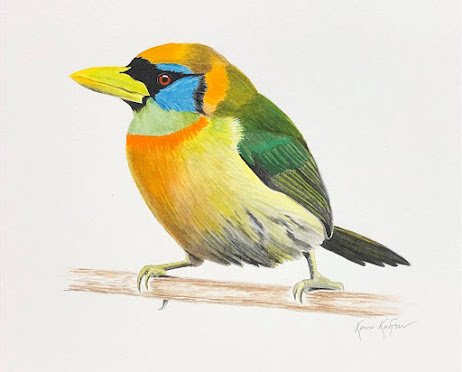Purple On The Rocks
We were reminded of that during our day of birding the Lake Erie shoreline in blizzard conditions on Nov. 18. Kim already told you about our visit to Huron Harbor early in the day (see her post "Extreme Birding"). The highlight of the afternoon came at Headlands Beach State Park, east of Cleveland, where we found two Purple Sandpipers along the breakwater.
The Purple Sandpiper is an incredibly tough creature. Its nesting range straddles the Arctic Circle in eastern Canada, mostly in areas that few birders ever visit. It stays in that freezing Arctic climate until very late in the fall. Then it just comes south to the colder regions of the Atlantic Coast, where it spends the winter scrambling around on coastal rocks that are battered by the waves. On the map here, red is the normal summer range, dark blue is the normal winter range, pale blue is where winter stragglers are seen, gray is where migrants pass through. Notice how much of the winter range is up in Canada -- on the rocky edge of Newfoundland, where freezing spray coats the rocks in wind chills of 40 below zero. Notice also that Lake Erie isn’t on the normal route at all (the text that goes with this map mentions that this is a rare visitor on the Great Lakes). We were cold today while we were watching the birds, but I’ve never been warm while I was watching Purple Sandpipers.
here, red is the normal summer range, dark blue is the normal winter range, pale blue is where winter stragglers are seen, gray is where migrants pass through. Notice how much of the winter range is up in Canada -- on the rocky edge of Newfoundland, where freezing spray coats the rocks in wind chills of 40 below zero. Notice also that Lake Erie isn’t on the normal route at all (the text that goes with this map mentions that this is a rare visitor on the Great Lakes). We were cold today while we were watching the birds, but I’ve never been warm while I was watching Purple Sandpipers.
Robert Hershberger spotted the birds first, ahead of us as we were making our way out along the huge jumbled rocks of the breakwater. We stalked them cautiously, but eventually we realized that they were coming toward us! Stunningly unconcerned about our presence, they kept coming closer until they were practically at our feet. What remarkable birds these were! We could see every detail of their sleek plumage, their stout orange legs, their blunt orange-based bills. Clambering about on the rocks at the very edge of the water, they were sometimes wading belly-deep, sometimes submerged when another wave crashed against the breakwater. We were bundled up in as many layers as we could carry and we were still chilled through, stung by the sleet hitting our faces -- but these Purple Sandpipers, tough and beautiful, seemed oblivious to the freezing blasts. Another tough and beautiful creature, Kim, found that her camera batteries had died in the cold, so she walked back half a mile to the parking lot to get fresh batteries and then stood in the driving wind and sleet and snow to shoot the Purple Sandpipers. Conditions were challenging for photography (slanting lines of snowflakes cross all the images, and in some we can see sleet piling up on the backs of the birds), but Kim got her pictures.
What remarkable birds these were! We could see every detail of their sleek plumage, their stout orange legs, their blunt orange-based bills. Clambering about on the rocks at the very edge of the water, they were sometimes wading belly-deep, sometimes submerged when another wave crashed against the breakwater. We were bundled up in as many layers as we could carry and we were still chilled through, stung by the sleet hitting our faces -- but these Purple Sandpipers, tough and beautiful, seemed oblivious to the freezing blasts. Another tough and beautiful creature, Kim, found that her camera batteries had died in the cold, so she walked back half a mile to the parking lot to get fresh batteries and then stood in the driving wind and sleet and snow to shoot the Purple Sandpipers. Conditions were challenging for photography (slanting lines of snowflakes cross all the images, and in some we can see sleet piling up on the backs of the birds), but Kim got her pictures.

Thinking about the extraordinary tameness of these birds, it occurred to me that they might not have had any prior experience of humans as something to be feared. They had come from a vast northern wilderness, and if they had come straight from the Arctic to this wild stretch of lakeshore, it was possible that we were the first humans they had ever seen.



I'm still in a deep purple haze from that awesome day! Thanks for filling in the blanks on these incredible birds, Kenn. Knowing that this blog would give you the opportunity to share this kind of information is exactly why I agreed to do it in the first place.
ReplyDeleteFun post, and a reminder how everything in birding is relative. I was nice and warm the first time I saw a Purple Sandpiper, as I was looking out the window of a restaurant on the coast of Iceland. Then I moved to the SW corner of Brooklyn and found that they regularly winter on the waterfront there. Even in New York City they are tame, easily observed from a few feet away with the Verrazano Bridge in the background.
ReplyDeleteMaybe "purple" refers to the colour of your hands when you're watching these birds? ;^D
ReplyDeleteThese remind me a little of wrybills, which are also remarkably unafraid — and similarly charismatic.
A striking bird. Tough sounds like a good description. That they are feeding in water oblivious to discomfort makes this seem so, all the more. Great images Kim!
ReplyDelete